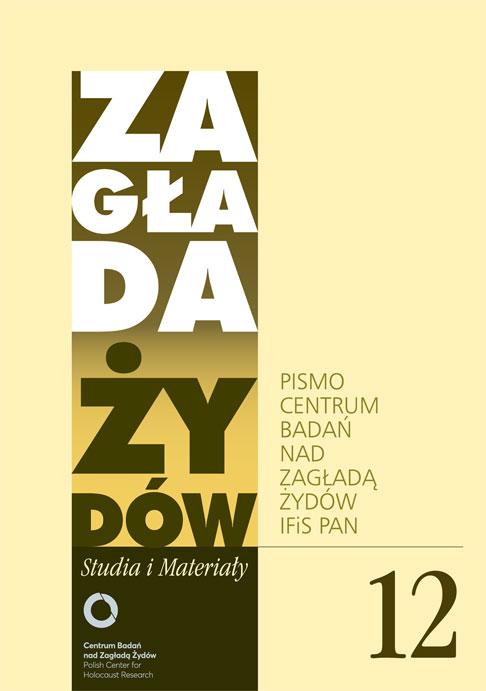Zagłada jako horror. Kilka uwag o literaturze polskiej 1985–2015
Zagłada Żydów. Studia i Materiały, Nr 12 (2016), Strony: 375-394
Data zgłoszenia: 2020-10-20Data publikacji: 2016-11-30
 https://doi.org/10.32927/ZZSiM.423
https://doi.org/10.32927/ZZSiM.423
Abstrakt
The author suggests that the depictions of the Holocaust in Polish literature of 1918–2014 should be categorized as horror. From the chronological perspective, Czapliński divides those thirty years into three shorter periods: 1) the initial period (from Claude Lanzmann’s Shoah and Jan Błoński’s essay “The Poor Poles Look at the Ghetto” to Wilhelm Dichter’s and Michał Głowiński’s memoirs) was dominated by white horror, which presented Jews as ghosts demanding a place in the Polish memory; 2) during the second period (from Marek Bieńczyk’s Tworki and Jan Tomasz Gross’ Neighbors until the end of the 2010s) the horror poetics was used to reveal those principles of pre-war and occupation-period normality which helped the Germans conduct the Holocaust and which conditioned the exclusion of Jews from the Polish circle of ‘normal humanity’; 3) during the third period (from Gross’s Golden Harvest until now) Jews return as the undead, violating the rules of distance and obliging Poles to physically touch the disgusting topic of the Holocaust. The contact with the Holocaust as something abhorring becomes a condition for self-knowledge, purging, and establishment of a new imaginary community.
Słowa kluczowe
Zagłada , horror , groza , obrzydliwość
Licencja
Prawa autorskie (c) 2016 Autor&"Zagłada Żydów. Studia i Materiały"

Utwór dostępny jest na licencji Creative Commons Uznanie autorstwa 4.0 Międzynarodowe.
https://creativecommons.org/licenses/by/4.0
Czasopismo publikowane jest w standardzie Diamond Open Access na licencji CC-BY-4.0 Deed - Uznanie autorstwa 4.0 Międzynarodowa - Creative Commons
Inne teksty tego samego autora
- Przemysław Czapliński, The Auschwitz Virus , Zagłada Żydów. Studia i Materiały: Nr Holocaust Studies and Materials (2017)
- Przemysław Czapliński, Prawda i co dalej , Zagłada Żydów. Studia i Materiały: Nr 15 (2019)
- Przemysław Czapliński, Wirus Auschwitz , Zagłada Żydów. Studia i Materiały: Nr 10 (2014)
Podobne artykuły
- Jacek Leociak, Stanislaw Sreniowski, From a Book of Madness And Atrocity , Zagłada Żydów. Studia i Materiały: 2008: Holocaust Studies and Materials
- Jan Grabowski, Józef Górski, At the Turn of History , Zagłada Żydów. Studia i Materiały: 2008: Holocaust Studies and Materials
- Agnieszka Haska, Międzynarodowa konferencja naukowa „Być świadkiem Zagłady”(Warszawa, 22–23 kwietnia 2013 r.) , Zagłada Żydów. Studia i Materiały: Nr 9 (2013)
- Agnieszka Haska, Sprawiedliwi są wśród nas , Zagłada Żydów. Studia i Materiały: Nr 10 (2014)
- Natalia Sineaeva-Pankowska, Jak zwiedzający odbierają galerię „Zagłada”. Z notatek przewodniczki , Zagłada Żydów. Studia i Materiały: Nr 12 (2016)
- Barbara Engelking, Żydzi i komuniści w okupowanej Warszawie , Zagłada Żydów. Studia i Materiały: Nr 14 (2018)
- Dariusz Libionka, Robert Kuwałek in memoriam , Zagłada Żydów. Studia i Materiały: Nr 10 (2014)
- Barbara Engelking, Sny jako źródło do badań nad Zagładą , Zagłada Żydów. Studia i Materiały: Nr 9 (2013)
- Jakub Petelewicz, In memoriam Raul Hilberg (1926–2007) , Zagłada Żydów. Studia i Materiały: Nr 3 (2007)
- Dariusz Libionka, Adam Kopciowski, Życie i Zagłada w Hrubieszowie w oczach młodej warszawianki , Zagłada Żydów. Studia i Materiały: Nr 3 (2007)
<< < 1 2 3 4 5 6 7 8 9 10 11 12 13 14 15 16 17 18 19 20 21 22 23 24 25 26 27 28 29 30 31 32 33 34 35 36 37 38 39 40 41 42 > >>
Możesz również Rozpocznij zaawansowane wyszukiwanie podobieństw dla tego artykułu.
 English
English
 Język Polski
Język Polski



 https://orcid.org/0000-0002-4805-6471
https://orcid.org/0000-0002-4805-6471

